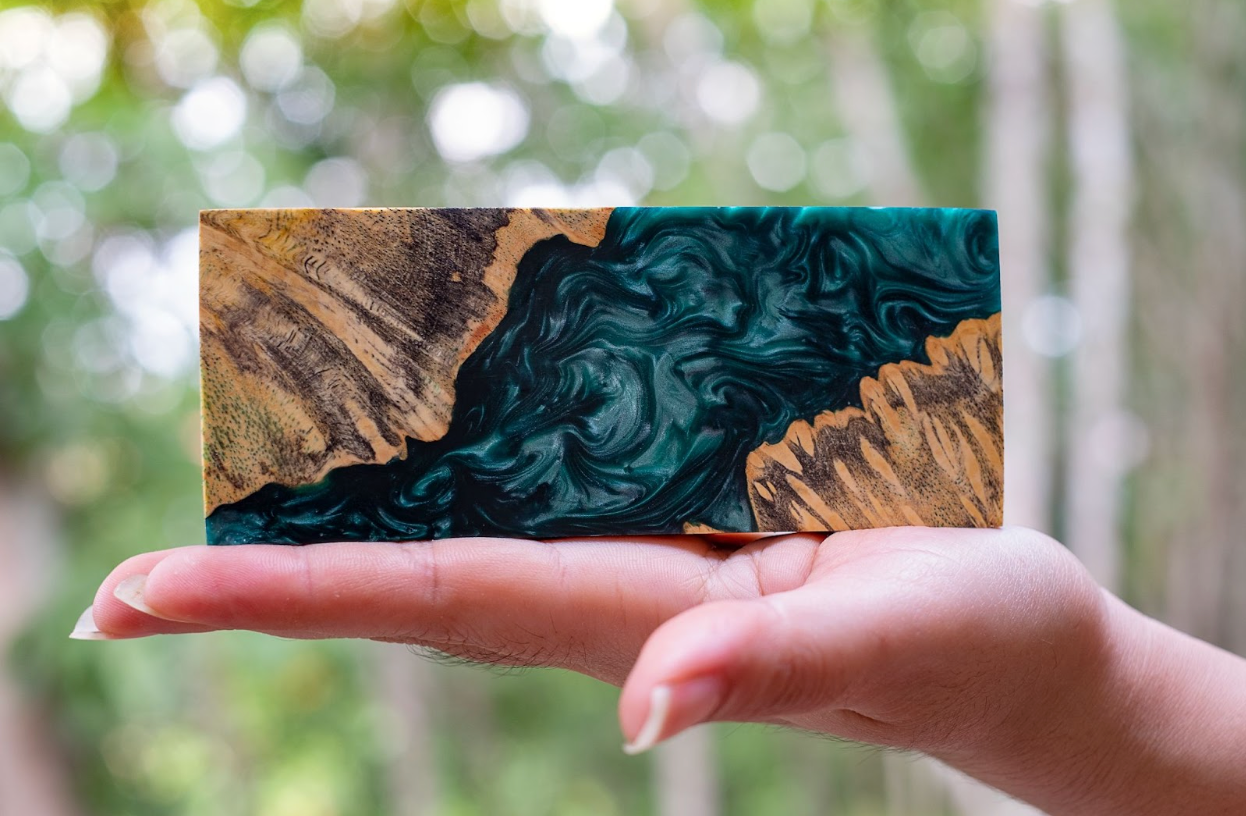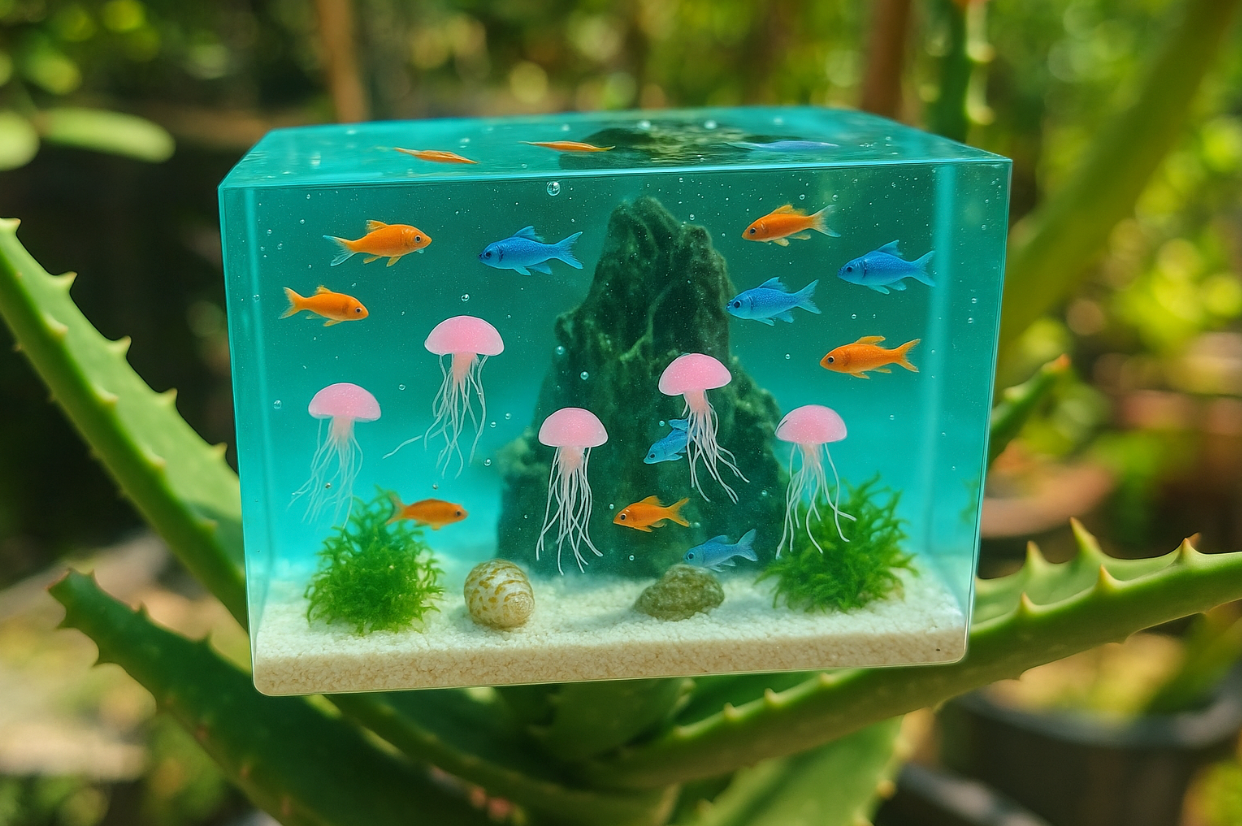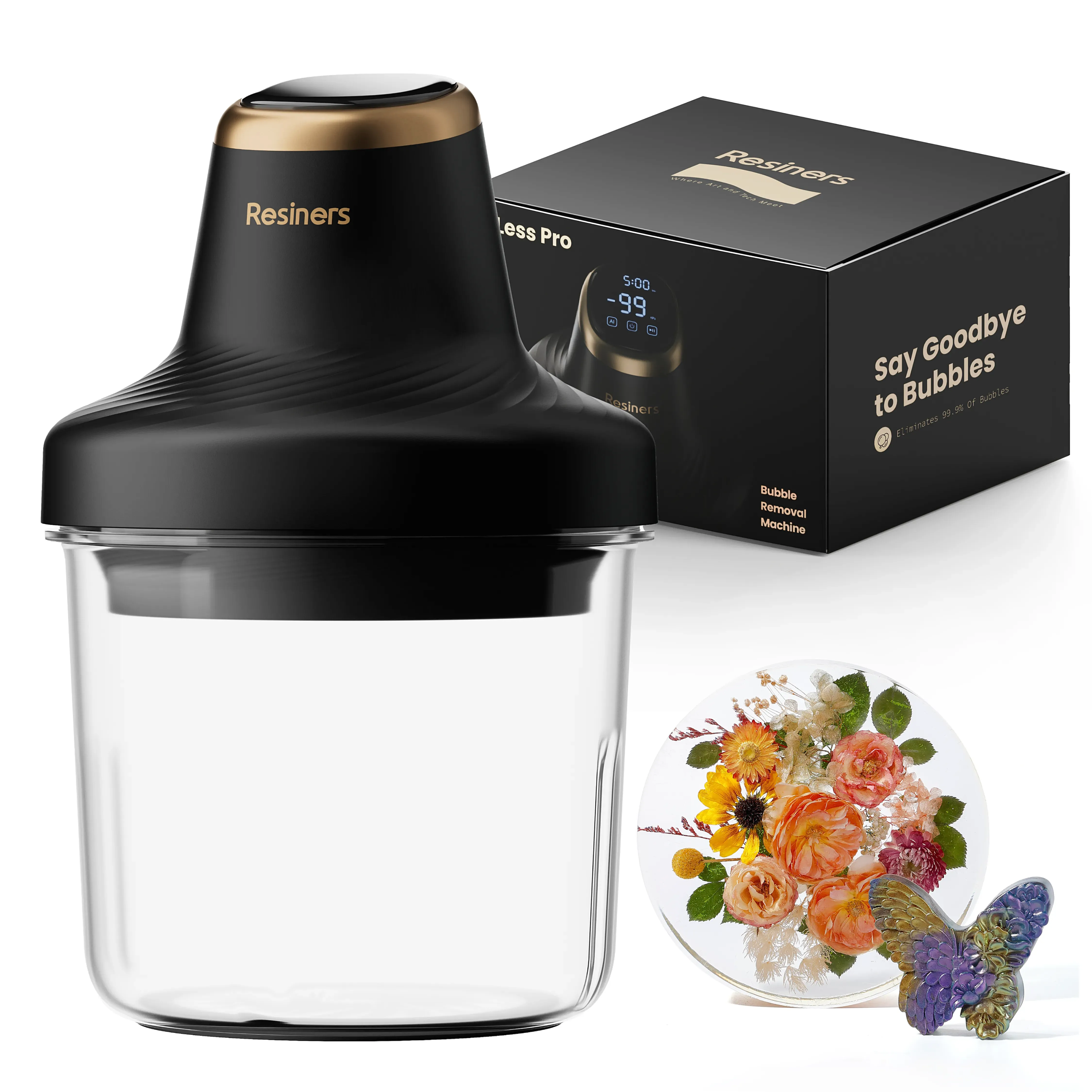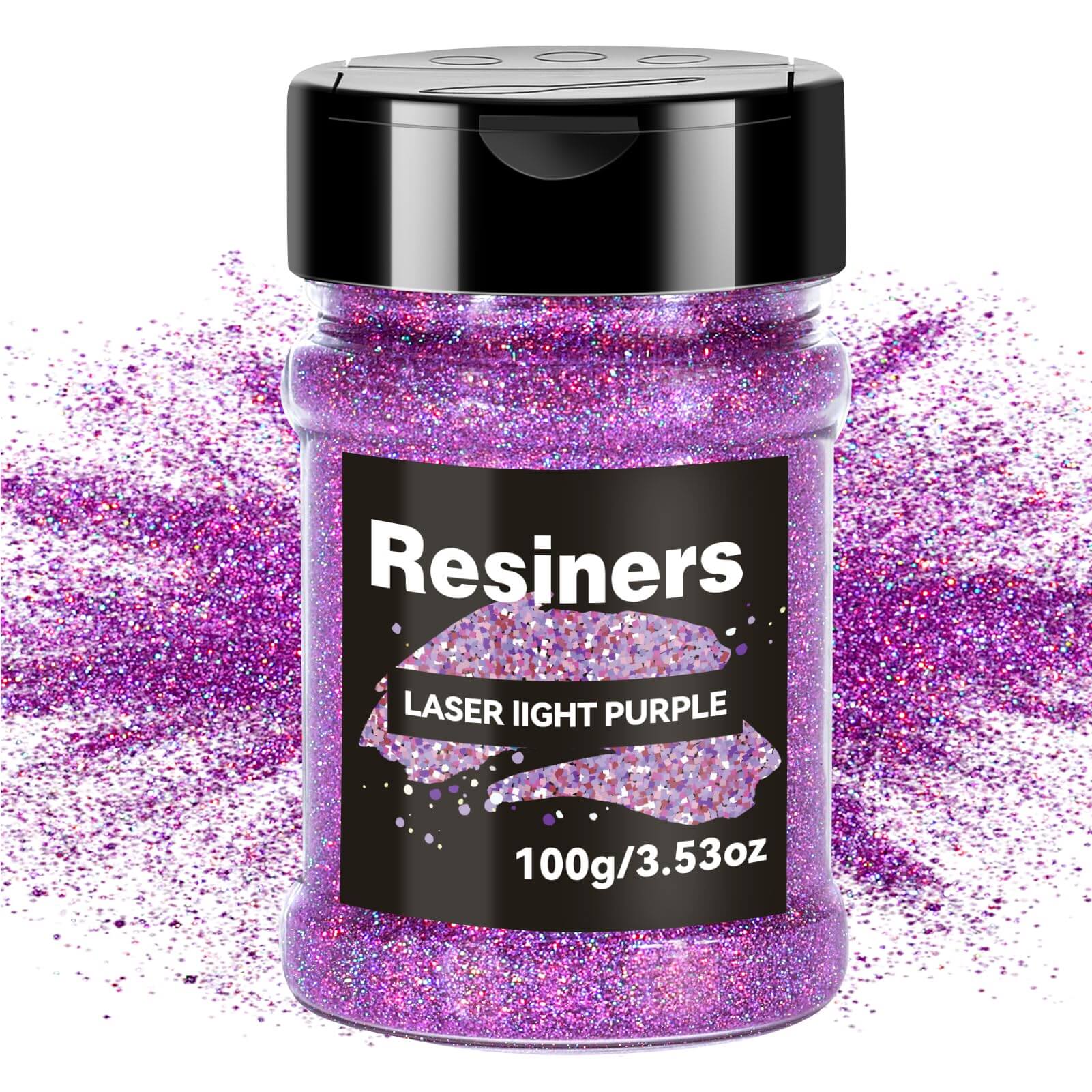Wondering if you can put epoxy on wood? Yes, you can! Epoxy resin transforms ordinary wood into stunning, durable pieces that last for years.
From river tables to countertops, epoxy creates a protective shield against moisture and daily wear while enhancing wood's natural beauty.
Epoxy's versatility lets you create clear coatings that showcase wood grain or add colors for custom designs. It works beautifully for repairs, art projects, and furniture that stands out.
Whether you're a beginner or experienced woodworker, understanding epoxy's properties and proper application techniques will help you achieve professional results.
Keep reading to discover everything you need for epoxy success!
Why Epoxy and Wood Make a Perfect Pair?
Wood and epoxy complement each other beautifully for several reasons:
✅ Strong Natural Bond
- Epoxy penetrates wood fibers, creating a connection that becomes part of the wood
- The porous nature of wood provides an excellent anchor for epoxy adhesion
- This natural bond creates a finish that won't easily peel or separate
✅ Enhanced Beauty
- Epoxy deepens wood grain colors like a magnifying glass
- Clear finish highlights subtle details that might otherwise go unnoticed
- Preserves and showcases character features like knots and burls
✅ Practical Benefits
- Fills imperfections while making them features rather than flaws
- Creates a waterproof barrier that protects wood from damage
- Can be colored, textured, or left crystal clear depending on your vision
Types of Epoxy for Wood Projects
Not all epoxies are created equal. Choose the right type for your specific project:
Table/Countertop Epoxy
- Self-leveling formulations for smooth, flat surfaces
- For food-contact surfaces, specifically choose FDA-compliant food-safe epoxy
- Hard, durable finish that withstands daily use
Epoxy Fillers
- Thicker consistency for filling cracks and holes
- Can be sanded and shaped once cured
- Available in wood-matching colors
Deep Pour Epoxy
- Pour depths vary by product, ranging from 1/8" to 4" in a single layer
- Special formulation prevents overheating during exothermic curing reactions
- Perfect for river tables and thick embedments
Structural Adhesives
- Creates bonds stronger than the wood itself
- Ideal for construction and joining wood pieces
- High resistance to temperature changes and moisture
Preparing Wood for Epoxy Application
Proper preparation is critical for epoxy success:
✅ Cleaning
- Remove all dust, oils, and previous finishes
- Wipe down with denatured alcohol to remove residues
- Ensure surface is completely dry and contaminant-free
✅ Sanding Process
- Start with 80-grit sandpaper to level the surface
- Progress to 150-180 grit for final preparation
- Don't sand too fine—epoxy bonds better to slightly textured surfaces
✅ Moisture Considerations
- Wood should have 7-12% moisture content
- Use a moisture meter to check if available
- Allow green wood to properly dry before applying epoxy
✅ Sealing Porous Woods
- Apply a thin seal coat to woods like oak and pine
- Let this initial layer soak in and cure
- Sealing prevents air bubbles in your final pour
Step-by-Step Guide to Applying Epoxy on Wood
Follow this comprehensive guide to achieve professional results when applying epoxy to your wood projects.
✅ Safety First
- Work in well-ventilated areas as some epoxies release VOCs during curing
- Consider wearing a respirator, especially with non-low-VOC formulations
- Always wear gloves to prevent skin contact with uncured epoxy
✅ Preparation
- Work in a clean environment at 70-80°F (21-27°C)
- Cover your workspace with plastic sheeting
- Use a level to ensure your project surface is perfectly flat
✅ Mixing Process
- Measure resin and hardener exactly per manufacturer's ratio
- Mix thoroughly for 3-5 minutes in a clean container
- Choose between fast or slow hardener based on your working time needs
Resiners® 1 gallon/2 gallon Crystal Clear Epoxy Resin with Tailored Diversion Port
✅ Application Techniques
- Pour in a thin, even layer for coating projects
- Use a plastic spreader to distribute evenly
- Work methodically from one end to another
✅ Bubble Removal
- Wait 5-10 minutes after pouring for bubbles to rise
- Use a heat gun or torch 6-8 inches from the surface
- Pass quickly over bubbles to pop them
✅ Working in Layers
- For thick pours, work in multiple thin layers
- Monitor temperature as thicker pours generate significant heat
- Follow product instructions for maximum pour depth
📌Check out our collection of high-quality epoxy resins designed specifically for woodworking applications!
Troubleshooting Common Epoxy-on-Wood Problems
Even experienced crafters encounter challenges with epoxy projects, but knowing how to troubleshoot common issues can save your work.
|
Problem |
Cause |
Prevention |
Solution |
|
Dealing with Bubbles |
Air trapped in wood grain or mixing process |
Seal coat, warm environment, careful mixing |
Heat gun or torch while epoxy is still liquid |
|
Fixing Uneven Surfaces |
Improper leveling or insufficient epoxy |
Use a level and calculate proper amount of epoxy |
Sand lightly and apply another thin coat |
|
When Epoxy Pulls Away from Edges |
Contaminants like oils or silicone on wood |
Proper cleaning and seal coat application |
Clean thoroughly, sand, and reapply |
|
Slow or Incomplete Curing |
Wrong mixing ratio, low temperature, expired product |
Ensure proper temperature and fresh materials |
Don't force curing with high heat as it can cause yellowing or brittleness |
📌 Learn everything about epoxy cure times for all your questions!
Finishing and Maintaining Epoxy-Wood Projects
The final steps of finishing and proper maintenance are crucial for ensuring your epoxy-wood creations maintain their beauty and durability.
Getting a Glass-Like Finish
- Allow full curing according to manufacturer specs (ranging from 72 hours to 7+ days)
- Wet-sand progressively from 320 grit to 2000+ grit for professional mirror finishes
- Apply polishing compound for mirror shine
Protecting from UV Damage
- Add a UV-resistant clear coat for outdoor pieces
- Position indoor pieces away from direct sunlight
- Consider UV-stabilized epoxy formulations which cost more but resist yellowing
Daily Maintenance
- Clean with mild soap and water only
- Avoid harsh chemicals and abrasive cleaners
- Apply paste wax every 6-12 months for extra protection
When Not to Use Epoxy on Wood
Consider these limitations before choosing epoxy:
✅ Environmental Factors
- Full sun exposure causes yellowing over time
- Heat resistance varies by product (typically 120-200°F/49-93°C)
- Very cold environments can make epoxy brittle
✅ Wood Compatibility Issues
- Oily exotic woods (teak, rosewood) may need special preparation
- Green wood with high moisture content causes curing problems
- Very soft woods may need stabilization before epoxy application
✅ Environmental and Practical Considerations
- Traditional finishes like tung oil or polyurethane have lower environmental impact
- Epoxy is not easily recyclable compared to other finishing options
- More expensive than traditional finishes
Expert Tips for Successful Epoxy-Wood Projects
Learn professional techniques from experienced artisans who have mastered the art of combining epoxy with wood.
For Bubble-Free Results
- Warm components in a water bath before mixing (80°F/27°C). Pre-seal porous woods with a thin epoxy layer. Work in a slightly warm environment.
Resiners® AirLess Resin Bubble Remover Machine
Coloring Techniques
- Start with minimal pigment—add gradually. Mix colors in small test batches first. Use alcohol-based or epoxy-specific colorants for best results and longevity.
Live Edge Mastery
- Stabilize bark with CA glue if keeping it. Clean thoroughly if removing bark. Create dams around irregular edges to contain epoxy.
Edge Finishing
- Build temporary dams with melamine and packing tape. Seal edges with hot glue or silicone caulk. Sand edges progressively for perfect sides.
📌 Explore our collection of the best clear epoxy resins for stunning results!
Conclusion
When choosing finishes for wood projects, epoxy offers unmatched durability and visual impact that traditional options can't deliver. While it requires some learning and specific conditions, the stunning results are worth the investment for special pieces.
At Resiners, we provide both the knowledge and materials you need for successful epoxy woodworking. Our comprehensive guides walk you through every step, while our quality resin products are formulated specifically for beautiful, long-lasting wood applications.
Ready to create something extraordinary? Browse our guides for inspiration or shop our premium epoxy collection to find the perfect formula for your next woodworking masterpiece. Your one-of-a-kind creation is just a pour away!
Frequently Asked Questions About Epoxy on Wood
Can you use regular epoxy on wood?
Yes, most standard epoxy resins work well on wood, but look for products specifically formulated for wood applications that offer proper penetration and flexibility. Some specialty woods may require specific epoxy types, and food-contact surfaces need FDA-compliant formulations. Always test compatibility on a scrap piece before committing to your entire project.
Does wood stick to epoxy?
Epoxy bonds extremely well to properly prepared wood as the porous nature allows epoxy to penetrate the surface, creating a strong mechanical bond. Proper preparation is critical—clean thoroughly, sand appropriately, and ensure complete dryness before application to achieve maximum adhesion. Some exotic woods with high oil content may require special degreasing procedures before epoxy will properly adhere.
What do you put on wood before epoxy?
For best results, seal wood with a thin coat of epoxy before your main pour to penetrate pores, prevent bubbles, and stop excessive absorption. This seal coat should be allowed to become tacky (but not fully cured) for most applications, creating the strongest chemical bond between layers. On extremely porous woods, you might need two seal coats to effectively seal all voids before your final pour.
When should you not use epoxy?
Avoid using epoxy on wood with high moisture content, in very humid environments, or for surfaces exposed to extreme heat or constant direct sunlight without proper UV protection. Consider more eco-friendly traditional finishes for projects where sustainability is priority, when working in poorly ventilated spaces, or when your budget is limited. Epoxy is also not ideal for surfaces that will experience frequent direct heat or cutting, as this can damage the finish over time.
How long does epoxy on wood last?
Indoor epoxy applications typically last 10-30 years with proper care, while outdoor applications may need recoating after 5-7 years due to UV exposure. Longevity varies based on epoxy quality, application technique, environmental conditions, and maintenance practices. Top-quality UV-stabilized epoxies with proper maintenance can significantly extend the life of your finished project.
Related articles:
Epoxy Resin vs UV Resin: What's the Difference?












اترك تعليقًا
This site is protected by hCaptcha and the hCaptcha Privacy Policy and Terms of Service apply.